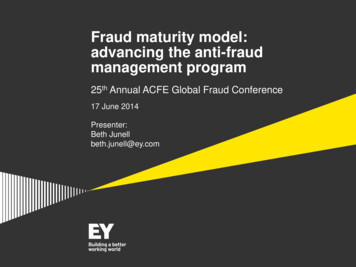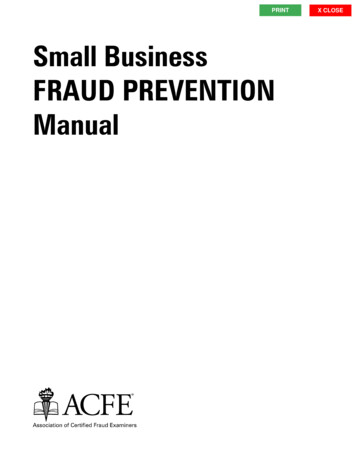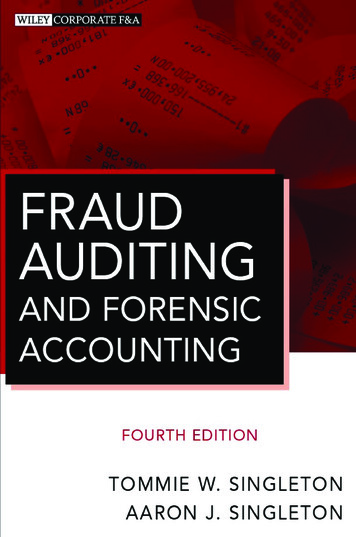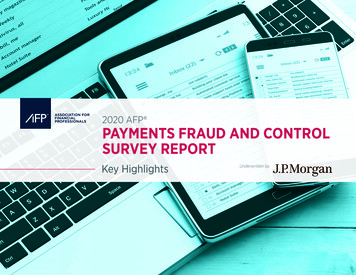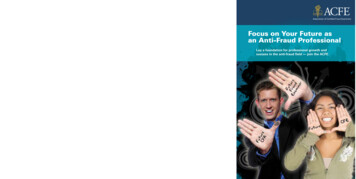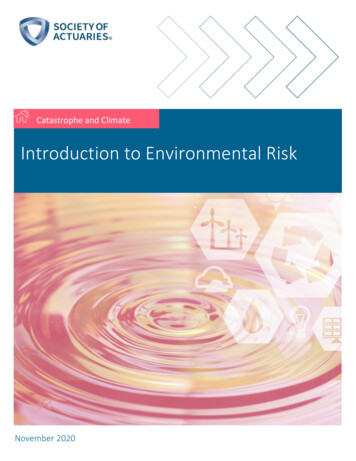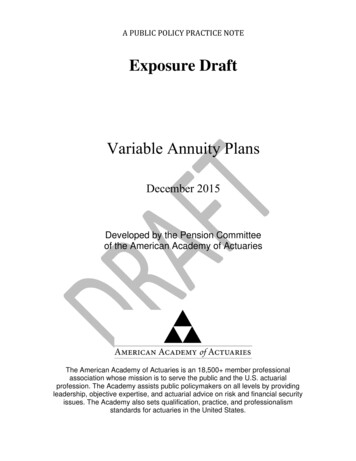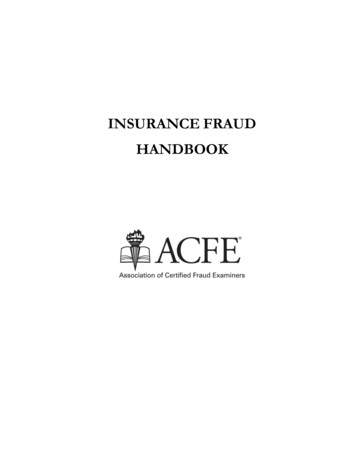
Transcription
INSURANCE FRAUDHANDBOOK
2009 By the Association of Certified Fraud Examiners, Inc.No portion of this work may be reproduced or transmitted in any form or by any meanselectronic or mechanical, including photocopying, recording, or by any informationstorage and retrieval system without the written permission of the Association.WORLD HEADQUARTERS, THE GREGOR BUILDING716 WEST AVENUE AUSTIN, TX 78701-2727 USATEL: (800) 245-3321 1 (512) 478-9000FAX: 1 (512) 478-9297http://www.ACFE.comDISCLAIMEREvery effort has been made to ensure that the contents of this publication areaccurate and free from error. However, it is possible that errors exist, bothtypographical and in content. Therefore, the information provided hereinshould be used only as a guide and not as the only source of reference.The author, advisors, and publishers shall have neither liability norresponsibility to any person or entity with respect to any loss, damage, orinjury caused or alleged to be caused directly or indirectly by any informationcontained in or omitted from this publication.Printed in the United States of America
JAMES E. WHITAKER, CFE, CPP, PCI, CIFIPresidentThe Whitaker Group, LLCJames E. Whitaker is the President and founder of the Whitaker Group, LLC, an investigativeservices and risk management consultant group headquartered in Ohio. As a retired police detectivedivision commander; FBI National Academy graduate; Special Investigations Unit (SIU) Directorand later a Claims Executive for a property and casualty insurance carrier; and Executive Directorfor the International Association of Arson Investigators, he has dealt extensively with insurancefraud in its many forms since 1971. He has a bachelor’s degree in Criminal Justice Administrationand a master’s degree in Management (with an emphasis on Organizational Design), both attainedfrom Myers University in Cleveland, Ohio.Mr. Whitaker has been a CFE since 1993 and is a Regent Emeritus as well as an adjunct facultymember for the ACFE. He has been a guest lecturer at ACFE Annual Conferences as well as ACFEChapters in Cincinnati, Columbus, Cleveland, Pittsburgh, Philadelphia, Baltimore, and New Orleans.Mr. Whitaker is a Certified Insurance Fraud Investigator and serves on both the Investigation andInsurance Fraud Councils (Co-Chair) for ASIS International. He also serves as an adjunct facultymember for ASIS on the PCI (Professional Certified Investigator) review course faculty. Mr.Whitaker is a frequent lecturer on the topic of insurance fraud across the U.S. and serves as aconsultant to various insurance companies on fraud related issues, employee training, and ethicsprogram development.
TABLE OF CONTENTSINSURANCE FRAUD OVERVIEWIntroduction to Insurance Fraud . 1Agent/Broker Fraud. 1Underwriting Irregularities . 2Vehicle Insurance Schemes . 4Property Schemes . 5Life Insurance Schemes . 6Liability Schemes. 6“Red Flags” of Insurance Fraud . 6Workers’ Compensation Fraud . 10ESTABLISHING AND MEASURING A NEW SPECIAL INVESTIGATION UNITIntroduction . 12Measurement Systems in Place . 14Who Measures? . 14How Often Are Measurements Taken? . 15Calculating Savings . 15Factors in Measuring Performance . 17Additional Rating Factors . 18Expensing SIU Costs . 18Areas of SIU Responsibility . 18SIU Personnel Selection. 20Technology Requirements . 22Data Mining and Link Analysis. 24Integrated Business Processes . 25Summary. 25THE POLICY: THE CONTRACTKnowing the Policy and its Language. 29The Policy as a Contract . 30First- and Third-Party Policies . 33Innocent Co-Insured . 34Mortgages and Loss Payees . 35Insurance Fraud Handbook-i-
TABLE OF CONTENTSCONDUCTING THE EXAMINATION UNDER OATHComponents of an Effective Examination Under Oath. 42The Interplay of the Arson and Fraud Defenses in a Fire Claim . 42Effective Use of the Examination Under Oath . 46The Examination Under Oath . 48The Uses of an Examination Under Oath . 49Conclusion . 54THE INSURANCE INTERVIEW PROCESSThe Preliminary Statement of the Insured or Claimant . 55Statement Methods . 57Witness Statements . 65INFORMATION GATHERING AND LEGAL ISSUES OF SHARINGImmunity Reporting Acts . 70Public Records Laws . 75Reciprocal Information Exchange . 77Disclosure . 78Recommended Procedures for Disclosure . 80Information Gathering . 81Domain Name Searching. 85Historical Website Information . 86Secretary of State Records . 86City/County Business Licensing. 86Newspaper Searches . 86Professional Licensing . 87UCC Filings . 87Treat All Information Obtained As a Lead. 87Conclusion . 87CONDUCTING SURVEILLANCEMethods of Surveillance. 90Preparation . 91Techniques of Foot Surveillance . 91Techniques of Vehicle Surveillance. 93Fixed Surveillance . 94Satellite Surveillance. 94Night Surveillance Equipment . 95Vendor Management . 95Conclusion . 102
TABLE OF CONTENTSEXPERT SELECTION PROCESSSelection Process Steps . 104Fire and Explosions . 106From Theory to the Courtroom . 109Spoliation—NFPA 921—Daubert—Systematic Approach. 111Validation of Expert Opinions . 114Scientific Testing: What Can a Laboratory Contribute to Your Case? . 116Insurance Fraud Handbook-iii-
Insurance Fraud OverviewINSURANCE FRAUD OVERVIEWIntroduction to Insurance FraudThe insurance business, by its very nature, is susceptible to fraud. Insurance is a risk distribution systemthat requires the accumulation of liquid assets in the form of reserve funds that are, in turn, available topay loss claims. Insurance companies generate a large steady flow of cash through insurance premiums.Steady cash flow is an important economic resource that is very attractive and easily diverted. Largeaccumulations of liquid assets make insurance companies attractive for take over and loot schemes.Insurance companies are under great pressure to maximize the return on investing the reserve funds,thus making them vulnerable to high yielding investment schemes.This section will introduce you to some of the most common types of fraud involving the insuranceindustry.Agent/Broker FraudCash, Loan, and Dividend ChecksA company employee without the knowledge of an insured or contract holder requests cash, a loan, or adividend check, and deposits the check into either his bank account or a fictitious account. Theemployee, in order to minimize his chances of being detected committing a fraudulent act, might changethe company policyholder’s address of record to either his address or a fictitious address. Once thecheck is issued, the address is then changed back to the previous address.Settlement ChecksA company employee can misdirect settlement checks, such as for a matured endowment settlement, tothe branch office, their home, or a fictitious address. The employee can easily create a check defalcationby changing the address of record prior to the settlement check issue date, thus misdirecting the checkin question. Also, an orphan contract holder might be transferred to his agency periodically, affordingthe opportunity to improperly request the issuance of a settlement check.An orphan contract holder is a policyholder or contract holder who has not been assigned to a servicingagent or the whereabouts of this individual is unknown. The servicing agent attempts to locate thisfamily group and could influence them to purchase additional insurance.Insurance Fraud Handbook-1-
Insurance Fraud OverviewPremium FraudThe agent collects the premium, but doesn’t remit the check to the insurance company. The insured hasno coverage.Fictitious PayeesAn agent or a clerk can change the beneficiary of record to a fictitious person and subsequently submitthe necessary papers to authorize the issuance of a check.Fictitious Death ClaimsAn agent or employee obtains a fictitious death certificate and requests that a death claim check beissued. The agent receives the check and cashes it.The sales representative can also write a fictitious application and, after the contestable period (twoyears), submit a phony death claim form and obtain the proceeds. The agent, by investing a fewthousand dollars, could receive 50,000 or more in misappropriated claims.Underwriting IrregularitiesEquity FundingEquity funding is the process of using existing premium/policy values to finance new businesses. Solong as the insured is aware of what is being done by the agent and fully understands the long rangemethod of payment on the new contract, there is no apparent underwriting irregularity.Equity funding techniques, also known as piggybacking, usually do not produce quality business.Furthermore, the company increases the amount of life insurance on the books but receives little or nonew funds while incurring increased sales and administrative expenses associated with the issue of thatnew business.MisrepresentationMisrepresentation might occur if a sales representative makes a false statement with the intent to deceivethe prospective insured in order to knowingly obtain an unlawful gain.False InformationA company employee might submit the following false information to obtain unlawful financial gain: Improper medical information to obtain a better insurable rate for the prospective policyholder-2-Insurance Fraud Handbook
Insurance Fraud OverviewImproper date of birth to obtain a cheaper premium on the new policy Improper home address to obtain a cheaper premium for home or automobile insurance Improper driving history prior to purchasing automobile insurance to reduce the annual premium orobtain insurance where normally the individual would have to apply through the risk pool Fictitious PoliciesA salesman, in order to keep his position, submits fictitious policies to improve his writing record. Or,prior to an individual leaving the company, he writes fictitious policies called tombstone cases to improvehis commission pool so that his compensation will be greater. Tombstone means an agent literally takesnames from tombstones in a cemetery and writes new policies.Surety and Performance Bond SchemesSurety and performance bonds guarantee that certain events will or will not occur. An agent may issueworthless bonds to the insured for high-risk coverage in hopes that a claim is never made. If a claim ismade, the agent might pay it off from agency funds, delay the payment, or skip town.SlidingSliding is the term used for including additional coverages in the insurance policy without the knowledgeof the insured. The extra charges are hidden in the total premium and, since the insured is unaware ofthe coverage, few claims are ever filed. For example, motor club memberships, accidental death, andtravel accident coverages can usually be slipped into the policy without the knowledge of the insured.TwistingTwisting is the replacement, usually by high pressure sales techniques, of existing policies for new ones.The primary reason, of course, is for the agent to profit, since first-year sales commissions are muchhigher than commissions for existing policies.ChurningChurning occurs when agents falsely tell customers that they can buy additional insurance for no cost byusing built-up value in their current policies. In reality, the cost of the new policies frequently exceedsthe value of the old ones.Insurance Fraud Handbook-3-
Insurance Fraud OverviewVehicle Insurance SchemesDitchingDitching, also known as owner give-up, is getting rid of a vehicle to cash in on an insurance policy or tosettle an outstanding loan. The vehicle is normally expensive and purchased with a small down payment.The vehicle is reported stolen, although in some cases, the owner just abandons the vehicle, hoping thatit will be stolen, stripped for parts, or taken to a pound and destroyed. The scheme sometimes involveshomeowner’s insurance for the property that was “stolen” in the vehicle.Past PostingPast posting is a scheme in which a person becomes involved in an automobile accident, but doesn’thave insurance. The person gets insurance, waits a little bit of time, reports the vehicle as being in anaccident, and then collects for the damages.Vehicle RepairThis scheme involves the billing of new parts on a vehicle when used parts were actually replaced in thevehicle. Sometimes this involves collusion between the adjuster and the body repair shop.Vehicle SmugglingThis is a scheme that involves the purchase of a new vehicle with maximum financing. A counterfeitcertificate of the vehicle’s title is made showing that it is free and clear. The vehicle is insured to themaximum, with minimum deductible theft coverage. It is then shipped to a foreign port and reportedstolen. The car is sold at its new location and insurance is also collected for the “theft.”Phantom VehiclesThe certificate of title is a document that shows the legal ownership of a vehicle. Even though it is notabsolute proof that a vehicle exists, it is the basis for the issuance of insurance policies. Collecting on aphantom vehicle has been shown to be easy to do.Staged AccidentsStaged accidents are schemes in which an accident is predetermined to occur on a vehicle. The schemesare organized by rings and the culprits move from one area to another. They often use the same vehicleover and over, which is sometimes what causes their scheme to be uncovered.-4-Insurance Fraud Handbook
Insurance Fraud OverviewInflated DamagesThe business environment and competition for work in the automobile repair industry have caused thedevelopment of a scheme in which some establishments inflate estimated costs to cover deductibles.The insured is advised by the repair shop that the shop will accept whatever the company authorizes.Vehicle Identification Number (VIN)-SwitchA VIN-switch is a fraud scheme in which a wrecked vehicle is sold and reported as being repaired. Thevehicle is not actually repaired; instead, the VIN plate is switched with that of a stolen vehicle of thesame make and model.Rental Car FraudA person doesn’t need to own a vehicle to commit automobile fraud. There are several schemes that canbe perpetrated using rental cars. The most prevalent involve property damage, bodily injury, and exportfraud.Property SchemesProperty schemes usually involve the filing of insurance claims for property that never existed or forinflated loss amounts.Inflated InventoryProperty that is lost through fire is claimed on an insurance form. However, property that doesn’t existalso finds its way onto an inventory of the property claimed. Property claimed might have beenpreviously sold or never owned by the claimant.Phony or Inflated TheftsA home or car that has been burglarized is the basis for filing a claim for recoveries of monies lost.However, as with items “destroyed” by fire above, the items never existed or were previously sold.Paper BoatsA claim is filed for a boat that sank, but the boat never actually existed. It is not difficult to register aboat based on a bill of sale. After a period of time, a loss is claimed for the sinking of the boat. It isdifficult to prove that the boat didn’t exist or was sunk intentionally.Insurance Fraud Handbook-5-
Insurance Fraud OverviewArson for ProfitPersonal dwellings or commercial properties are destroyed by fire for the sole purpose of financial gain.Insureds may act alone or in concert with agents or highly organized crime rings specializing in arson.Life Insurance SchemesFraudulent Death ClaimsTo obtain reimbursement for life insurance, a death certificate is required. However, phony deathcertificates are not that difficult to obtain. The person might be very much alive and missing or theperson might be dead, and the death is past posted. With small settlements, death claims aren’t closelyscrutinized and are paid relatively easily.Murder for ProfitThis scheme involves the killing (or arranging for the killing) of a person in order to collect insurance.The death might be made to look like it was an accident or a random killing.Liability SchemesIn a liability scheme the claimant has claimed an injury that did not occur. The slip and fall scam is themost common, and involves a person claiming to fall as the result of negligence on behalf of theinsured.“Red Flags” of Insurance FraudRed flags of insurance fraud may include any of the following: The claim is made a short time after inception of the policy, or after an increase or change in thecoverage under which the claim is made. This could include the purchase of a scheduled property orjewelry floater policy, or more than one during the time before the loss. The insured has a history of many insurance claims and losses.Before the incident, the insured asked his insurance agent hypothetical questions about coverage inthe event of a loss similar to the actual claim. The insured is very pushy and insistent about a fast settlement, and exhibits more than the usualamount of knowledge about insurance coverage and claims procedures, particularly if the claim isnot well documented. In a burglary loss, the claim includes large, bulky property that is unusual for a burglary. -6-Insurance Fraud Handbook
Insurance Fraud OverviewIn a theft or fire loss claim, the claim includes a lot of recently purchased, expensive property, or theinsured insists that everything was the best or the most expensive model, especially if the insuredcannot provide receipts, owner’s manuals, or other documentary proof of purchase. In a fire loss claim, property considered personal or sentimental to the insured and that you wouldexpect to see among the lost property (such as photographs, family heirlooms, or pets) isconspicuous by its absence. A large amount of the property was purchased at garage and yard sales and flea markets, orotherwise for cash, and there are no receipts (the insured will be unable to recall exactly where thesesales took place or by whom). The insured cannot remember, or does not know, where he or she acquired the claimed property, especially unusual items, and/or he cannot provide adequate descriptions.On the other hand, the insured already has receipts and other documentation, witnesses, andduplicate photographs for everything; the claim is too perfect. Documentation provided by the insured is irregular or questionable, such as: Numbered receipts are from the same store and dated differently or sequentially. Documents show signs of alteration in dates, descriptions, or amounts. Photocopies of documents are provided and the insured cannot produce the originals. Handwriting or signatures are similar on different receipts, invoices, gift verifications, orappraisals. The amount of tax is wrong, either for the price of the property or for the date appearing on thereceipt.Receipts, invoices, or shipping documents do not have “paid,” “received,” or other shippingstamps.In a theft or loss away from home, the insured waits an unusually long time before reporting thetheft to the police.The insured is able to give the police a complete list of lost property on the day of the burglaryor shortly after.The amount of the claim differs from the value given by the insured to the police.In a business inventory or income loss claim, the insured does not keep complete books, or thebooks do not follow accepted accounting principles.The physical evidence is inconsistent with the loss claimed by the insured.In a burglary loss, there is no physical evidence of breaking and entering, or a burglary could nothave occurred unnoticed under the circumstances.In a fire loss:Insurance Fraud Handbook-7-
Insurance Fraud Overview The apparent cause and origin of the fire is inconsistent with an accidental cause and origin, or there is evidence of the use of an accelerant. The remains of the property do not match the claimed property.The premises do not show signs of having contained the claimed property, or the amount ofproperty would not fit into the space where the insured says it was.Physical damage to the insured’s car is inconsistent with its having been in a collision with anuninsured car.The insured has discarded the claimed damaged property before the adjuster can examine it.The cost of the claimed property, over the period of time it allegedly was acquired, seems toexceed the insured’s financial ability to purchase it. The insured refuses or is unable to answer routine questions. The insured provides supporting evidence and documentation that cannot be corroborated.Information on a life application is very vague or ambiguous as to the details of health history, suchas dates, places of treatment, names of physicians or hospitals, or specific diagnoses.Applicant fails to sign and date the application.Pertinent questions on the application are not answered, such as income, other insurance carried,hazardous duties, or aviation or flying activity.The insured has “excess insurance,” either shown at the time of application or developed through anunderwriting report of database information.Earned income does not warrant the amount of insurance being applied for.The applicant’s date of birth as shown on the application is much earlier than shown with othercarriers or in previous applications or policies.The agent is putting on a great deal of pressure to have the policy issued because of the largeamount applied for, but is going over the underwriter’s head in order to do so (working out of thesystem).The physician’s report is very vague on details of past medical history and does not coincide with theinformation shown on the application.A death claim is presented in which the death has taken place outside of the country.The signature on the application for insurance does not appear to be the same signature as shownon an authorization at the time of the claim. A claimant or a claimant’s attorney attempts to limit the type of information to be related by asigned authorization, which is a standard authorization used by the company. An attorney is immediately brought into a contestable death claim, attempting to interfere with theinvestigation and to withhold information required by the company.-8-Insurance Fraud Handbook
Insurance Fraud OverviewA contestable death claim is reported as an accidental death, but could possibly be a suicide (such asa fatal accident involving only one vehicle, a hunting accident, or an accidental shooting whilecleaning or repairing a weapon). An autop
Insurance Fraud Councils (Co-Chair) for ASIS International. He also serves as an adjunct faculty member for ASIS on the PCI (Professional Certified Investigator) review course faculty. Mr. Whitaker is a frequent lecturer on the topic of insurance fraud across the U.S. and serves as a
